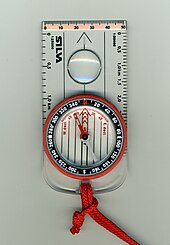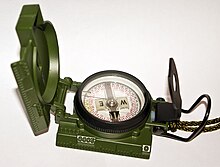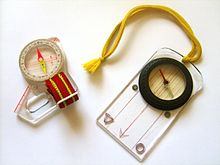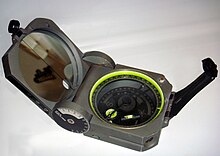Modern compasses
Modern compasses usually use a magnetized needle or dial inside a capsule completely filled with fluid (oil, kerosene, or alcohol is common). While older designs commonly incorporated a flexible diaphragm or airspace inside the capsule to allow for volume changes caused by temperature or altitude, modern liquid compasses utilize smaller housings and/or flexible materials for the capsule itself to accomplish the same result. The fluid dampens the movement of the needle and causes the needle to stabilize quickly rather than oscillate back and forth around magnetic north. North on the needle or dial, as well as other key points are often marked withphosphorescent, photoluminescent, or self-luminous materials[73] to enable the compass to be read at night or in poor light.
Many modern recreational and military compasses integrate a protractor with the compass, using a separate magnetized needle. In this design the rotating capsule containing the needle has a transparent base containing map orienting lines as well as an orienting 'box' or outline for the needle.[74] The capsule is then mounted in a transparent baseplate containing a direction-of-travel (DOT) indicator for use in taking bearings directly from a map.[74]
Other features found on some modern compasses are map and romer scales for measuring distances and plotting positions on maps, luminous markings on the face or bezels, various sighting mechanisms (mirror, prism, etc.) for taking bearings of distant objects with greater precision, "global" needles for use in differing hemispheres, adjustable declination for obtaining instant true bearings without resort to arithmetic, and devices such as inclinometers for measuring gradients.[74]
The military forces of a few nations, notably the United States Army, continue to utilize lensatic field compasses with magnetized compass dials or cards instead of needles. A lensatic-card compass permits reading the bearing off the compass card with only a slight downward glance from the sights (see photo), but may require a separate protractor for use with a map.[74][75] The official U.S. military lensatic compass does not use fluid to damp needle swing, but ratherelectromagnetic induction to damp the needle. A "deep-well" design is used to allow the compass to be used globally with little or no effect in accuracy caused by a tilting compass dial. As induction forces provide less damping than fluid-filled designs, a needle lock is fitted to the compass to reduce wear, operated by the folding action of the rear sight/lens holder. The use of air-filled induction compasses has declined over the years, as they may become inoperative or inaccurate in freezing temperatures or humid environments.[76]
Some military compasses, like the U.S. SandY-183 (name derived from Stocker & Yale) military lensatic compass, the Silva 4b Militaire, and the Suunto M-5N(T) contain the radioactive material tritium (3H) and a combination of phosphors.[77] The U.S. military compass, made by Stocker & Yale (later, Cammenga) contained 120 mCi (millicuries) of tritium. The purpose of the tritium and phosphors is to provide illumination for the compass, via radioluminescent tritium illumination, which does not require the compass to be "recharged" by sunlight or artificial light.[78]
Mariner's compasses can have two or more magnetic needles permanently attached to a compass card. These move freely on a pivot. A lubber line, which can be a marking on the compass bowl or a small fixed needle indicates the ship's heading on the compass card. Traditionally the card is divided into thirty-two points (known as rhumbs), although modern compasses are marked in degrees rather than cardinal points. The glass-covered box (or bowl) contains a suspended gimbal within a binnacle. This preserves the horizontal position.
[edit]Thumb compass
Main article: Thumb compass
A thumb compass is a type of compass commonly used in orienteering, a sport in which map reading and terrain association are paramount. Consequently, most thumb compasses have minimal or no degree markings at all, and are normally used only to orient the map to magnetic north. Thumb compasses are also often transparent so that an orienteer can hold a map in the hand with the compass and see the map through the compass.
[edit]Gyrocompass
Main article: Gyrocompass
A gyrocompass is similar to a gyroscope. It is a non-magnetic compass that finds true north by using an (electrically powered) fast-spinning wheel and friction forces in order to exploit the rotation of the Earth. Gyrocompasses are widely used on ships. They have two main advantages over magnetic compasses:
- they find true north, i.e., the direction of Earth's rotational axis, as opposed to magnetic north,
- they are not affected by ferromagnetic metal (including iron, steel, cobalt, nickel, and various alloys) in a ship's hull. (No compass is affected by nonferromagnetic metal, although a magnetic compass will be affected by any kind of wires with electric current passing through them.)
Large ships typically rely on a gyrocompass, using the magnetic compass only as a backup. Increasingly, electronic fluxgate compasses are used on smaller vessels. However compasses are still widely in use as they can be small, use simple reliable technology, are comparatively cheap, often easier to use than GPS, require no energy supply, and unlike GPS, are not affected by objects, e.g. trees, that can block the reception of electronic signals.
[edit]Solid state compasses
Main article: Magnetometer
Small compasses found in clocks, mobile phones, and other electronic devices are solid-state compasses, usually built out of two or three magnetic field sensors that provide data for a microprocessor. The correct heading relative to the compass is calculated using trigonometry.
Often, the device is a discrete component which outputs either a digital or analog signal proportional to its orientation. This signal is interpreted by a controller or microprocessor and used either internally, or sent to a display unit. The sensor uses highly calibrated internal electronics to measure the response of the device to the Earth's magnetic field.
GPS receivers using two or more antennae can now achieve 0.5° in heading accuracy (e.g.[79]) and have startup times in seconds rather than hours for gyrocompass systems. Manufactured primarily for maritime applications, they can also detect pitch and roll of ships.
[edit]Specialty compasses
Apart from navigational compases, other specialty compasses have also been designed to accommodate specific uses. These include:
- Qibla compass, which is used by Muslims to show the direction to Mecca for prayers.
- Optical or prismatic hand-bearing compass, most often used by surveyors, but also by cave explorers, foresters, and geologists. This compasses ordinarily uses a liquid-damped capsule[80] and magnetized floating compass dial with an integral optical (direct or lensatic) or prismatic sight, often fitted with built-in photoluminescent or battery-powered illumination.[74] Using the optical or prism sight, such compasses can be read with extreme accuracy when taking bearings to an object, often to fractions of a degree. Most of these compasses are designed for heavy-duty use, with high-quality needles and jeweled bearings, and many are fitted for tripod mounting for additional accuracy.[74]
- Trough compasses, mounted in a rectangular box whose length was often several times its width, date back several centuries. They were used for land surveying, particularly with plane tables.





No comments:
Post a Comment